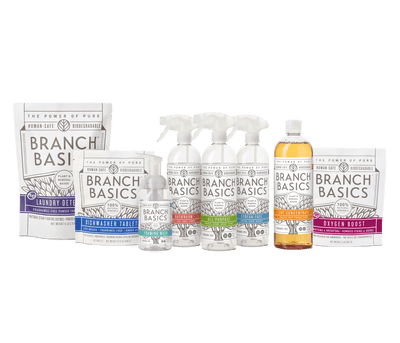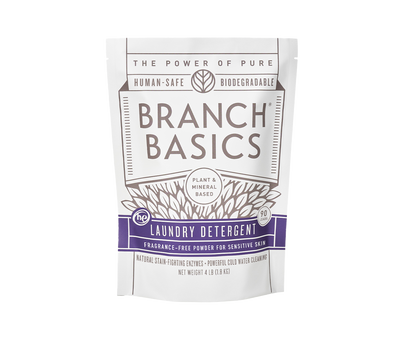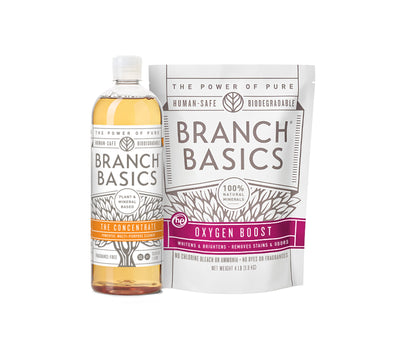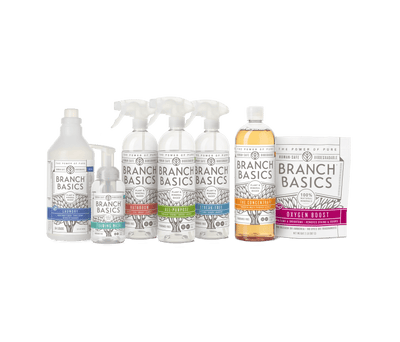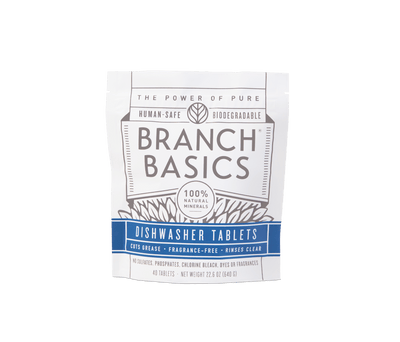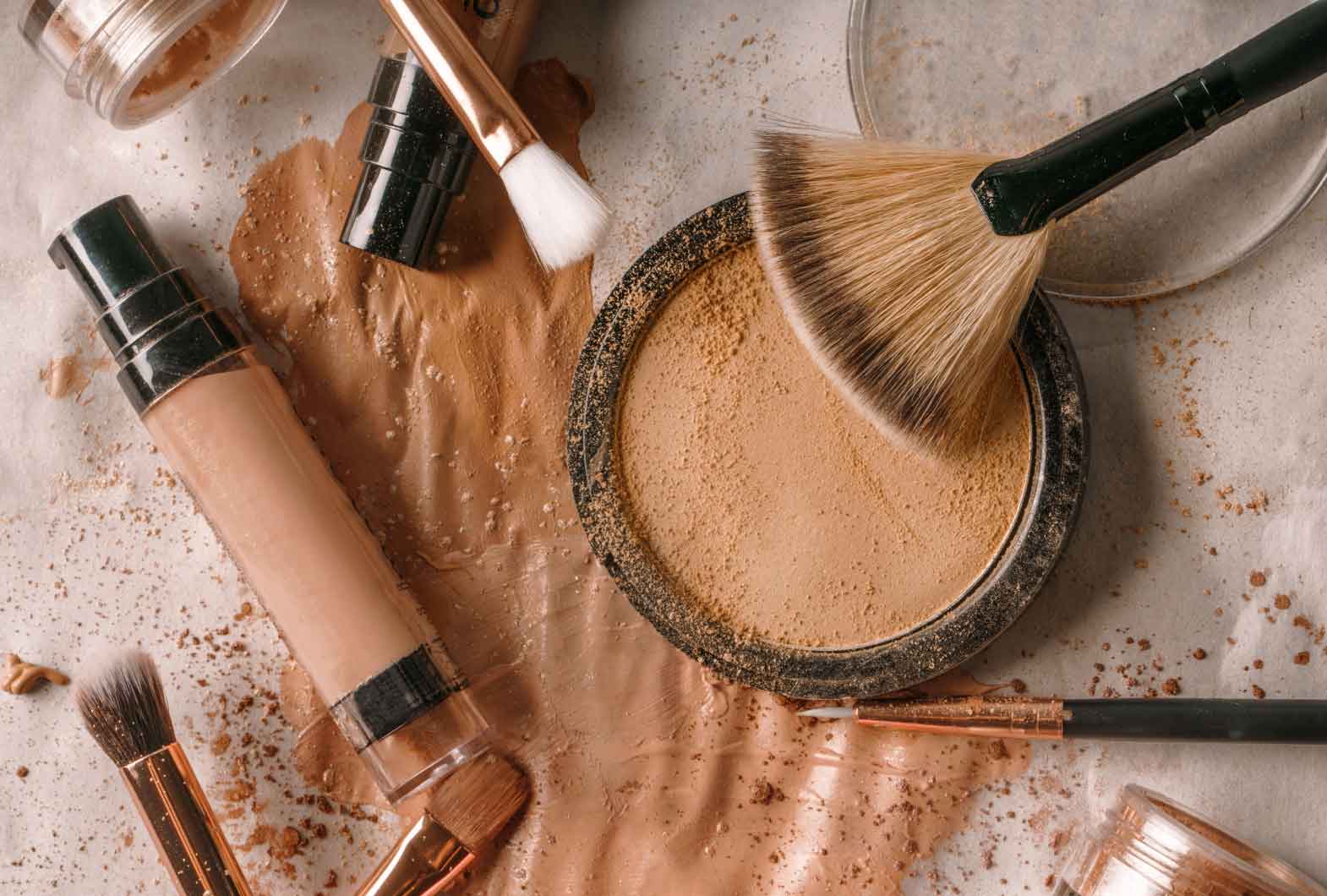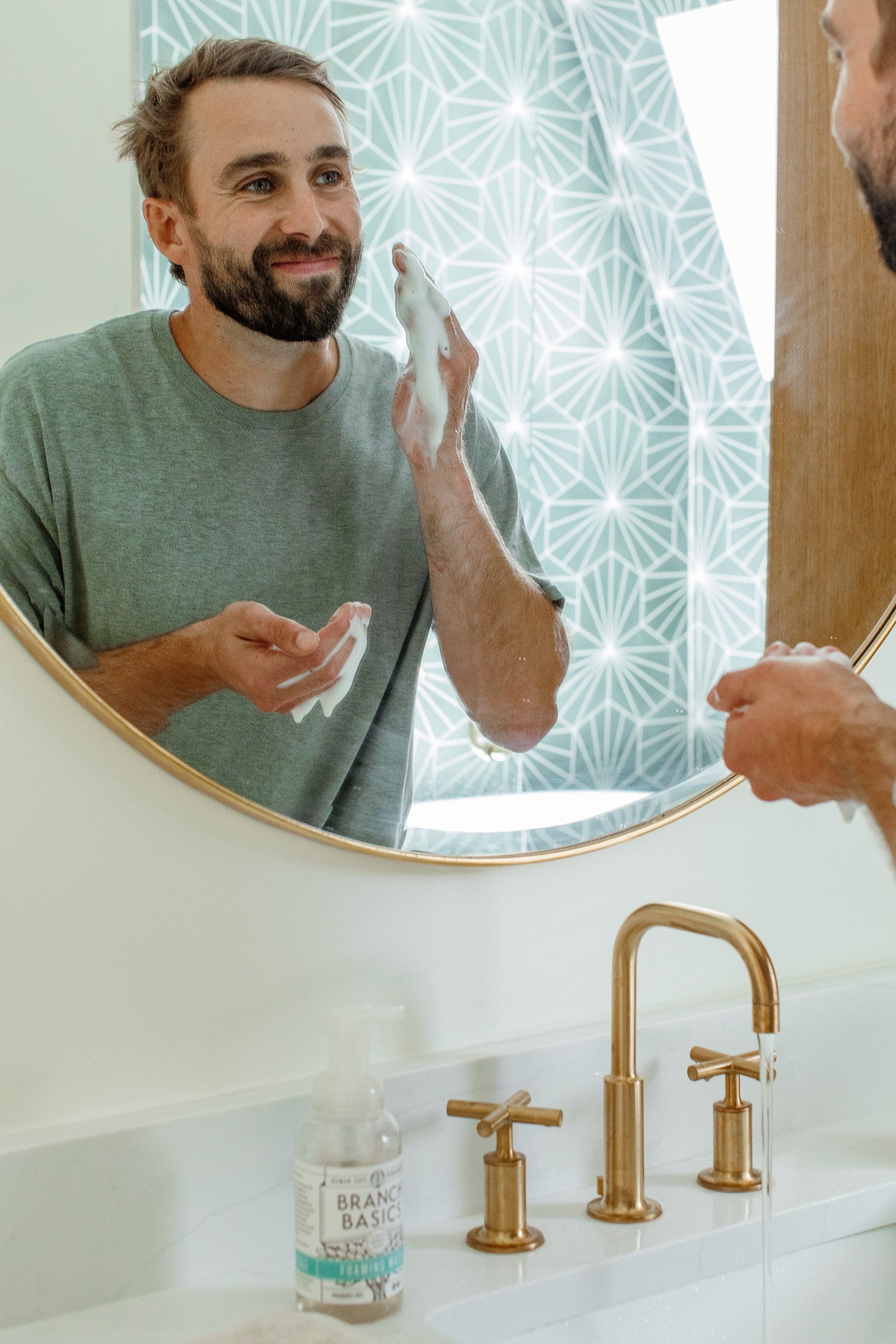Our Favorite Non-Toxic Personal Care Products
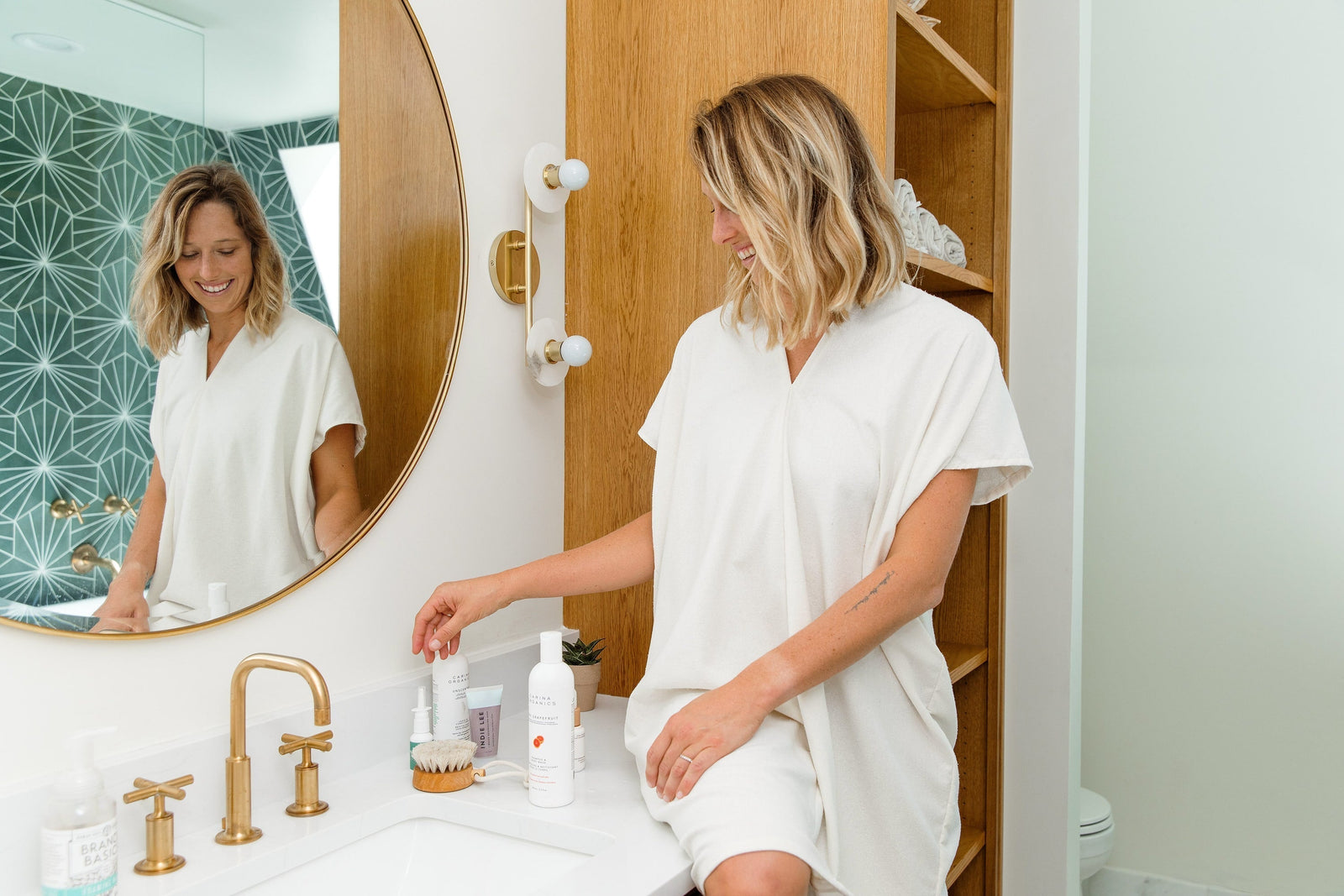
We’ve had a lot of you ask us what our favorite personal care products are, so we thought compiling a list of what we use (along with some other great options) would be helpful!
Ensuring that the products you bring into your home are free of harmful chemicals is crucial to creating a healthy home, and that’s especially true for the products you put onto your body! With a market that has (thankfully!) grown rapidly over the past few years, it can be hard to sort through all of the “safe”, “natural” and “non-toxic” claims.
3 Quick and Easy Ways to Vet Products
You don't have to be a chemist or have a scientific background to read labels and evaluate ingredients. You can vet products very quickly and feel confident about your decisions because we have some great tools at our fingertips.
1. Toxic Red Flags:
Sometimes a quick scan of the label for toxic red flags can determine right away if the product is safe or not. Toss products with toxic red flag ingredients such as synthetic fragrance, parfum, perfume, phenoxyethanol, parabens, phthalates, BHA, BHT, formaldehyde releasing preservatives, MIT – isothiazolinone family, benzalkonium chloride , petrolatum, mineral oil, propylene glycol, sodium laurel/laureth sulfate, artificial colorants, retinol, retinyl palmitate, hydroquinone, PEG ingredients, polysorbate 60 and 80, and polyethylene glycol.
2. Be Your Own Expert:
If there are no familiar toxic red flags, investigate the ingredients one by one. Go to EWG’s Skin Deep Cosmetics Database. Type in each ingredient into the search bar. The ingredients are rated from 1-10- with 1 being the safest to 10 being the most toxic. Typically, the safest ingredients to put on the skin will be rated 1 or 2. Toss products that contain an ingredient that rates 3 or more.
Tip: Start with the last ingredient to save time. You will find preservatives here, many of which have high ratings. Toss the product as soon as you find an ingredient rated 3 or more.
We also love the Think Dirty app for checking particular products. We recommend only using products rated 0.
3. New to Toss the Toxins? Go Fragrance Free
Establish a baseline of using fragrance free products in your home to encourage the strongest immune system for your family. Fragranced products can trigger allergic, immune, stress and hormonal responses that can lower immune system function.
If anyone in your family suffers from allergies, headaches, digestive difficulties, asthma, or any chronic illness going fragrance free (this includes essential oils) is essential when creating a healthy home and body.
Initially we recommend Tossing the Toxins to Create a Healthy Home by removing all products with harmful ingredients from the home. This removal includes all synthetic fragrance and non-organic essential oils processed with solvents. And, temporarily, even wildcrafted and organic essential oils processed without solvents should be removed. Essential oils are so concentrated that they can cause an inflammatory response and have been shown to hijack the healing process. Also, if not processed carefully, it has been found that some products with organic essential oils are contaminated with phthalates.
Are Essential Oils Safe in Personal Care Products?
Essential oils have been used for thousands of years as medicines, in perfumes, cosmetics, and to freshen the air. If used properly, they can be a powerful healing tool!
In today’s world, we are discovering an unintended consequence of the mass marketing and production of essential oils. I first became aware of this being an issue when I was working with clients with chronic illness thirty years ago. I had discovered that going completely fragrance-free was a critical point for the recovery of most of my clients. Many were using essential oils as a healing tool. Some were using them constantly, diffusing oils, ingesting them, and using them on the skin. Removing all oils from the home, as I would guide them to go fragrance-free while healing, resulted in improvement or even resolution of symptoms. This happened over and over. They didn’t realize how much they were being impacted until they were removed!
My experience with clients started to be scientifically substantiated In 2007 when Anne Steineman began testing “green” products. All essential oils tested emitted hazardous chemicals with no significant difference between organic and non-organic. She also found emissions of harmful VOCs, from all fragranced products regardless of claims of organic, green, and non-toxic claims.
Many of my clients with endocrine disruption only had their condition resolved once essential oils were removed. Essential oils do not contain phthalates, but if they have been processed through plastic tubing, they pick up the phthalates which are endocrine disruptors. In addition, studies have shown that harmful small particulates are released when certain essential oils are diffused impacting cognitive function.
The American Lung Association warns against inhaling essential oils directly and stresses that essential oils must only be used with care. The impact of essential oils from the terpene family on indoor air quality is a concern as levels of secondary pollutants such as formaldehyde and secondary organic aerosols/particulate matter (SOAs) are formed in the presence of ozone. Used improperly or manufactured with solvents or with plastic tubing, essential oils are a health threat to our families.
Common Ingredients Found in Personal Care Products
We have looked at ingredients that are commonly found in personal care to shed more light on why we would or would not use products with these ingredients. Many of the ingredient ratings below from EWG depend on usage, how much of the ingredient is in the formula, and other factors.
Below are a few very common personal care ingredients that do not meet our typical standards of being 1 or 2 on the EWG Skin Deep scale but might be exceptions to consider when looking for personal care products.
The order in which the ingredients appear on the label matters. The higher an ingredient appears on the list, the more it is in the product. Ideally, the following ingredients would be towards the end of the list.
- Silica (1-3)
- Silica, similar to sand, is generally safe for personal care products unless directly inhaled.
- *Sodium benzoate (1-3)
- This preservative is widely used in many non-toxic products. If you're prone to sensitivity, it's wise to monitor your skin's reaction. It is an ingredient we typically recommend avoiding, especially if you have sensitive skin, are prone to inflammation, or have chronic illness.
- Glyceryl behenate (1-3)
- This fat, used to increase viscosity, may cause irritation, particularly in products near the eyes or in spray form.
- Zinc oxide (1-3)
- As a colorant and sunscreen agent, zinc oxide may pose respiratory risks, especially in sprays or powders.
- *Citric acid (1-2)
- We usually recommend avoiding citric acid, especially in food. While commonly used as a preservative or for its antibacterial properties, citric acid can cause redness and rashes in sensitive individuals. Exercise caution, especially if you have sensitive skin.
- Camellia sinensis (green tea) leaf extract (2)
- Generally safe, though it may irritate sensitive skin. Monitor your skin's reaction when using products containing this extract.
- Chamomilla recutita (matricaria) flower extract (1-4)
- Certain types of chamomile may irritate if inhaled from spray or powder products. If you are sensitive, look for products with allergen-free chamomile.
- Camomile oil is typically more inflammatory than the extracts
- Sodium hydroxide (1-4)
- Also known as lye, sodium hydroxide, an ingredient in formulas, is safe once mixed with other ingredients.
- *Benzoic acid (1-3)
- A preservative similar to sodium benzoate may cause skin irritation, particularly for sensitive individuals.
Note: People trying to heal inflammatory skin conditions (such as eczema), hormone disruption, or chronic illness should also avoid products used on the skin with inflammatory ingredients (citric acid, sodium coco sulfate, phenoxyethanol, sodium benzoate, benzoic acid, potassium sorbate, and any ingredient with a quaternary ammonium component like polyquarternium).
Common Ingredients To Avoid Using
- Dimethicone- 4
- Dimethicone, while widely used, has raised concerns due to evidence suggesting toxicity to our organs. It is also persistent in the body and doesn't detoxify quickly.
- Phenoxyethanol- 4
- This commonly found preservative has faced scrutiny for its potential health risks. It can exacerbate and cause skin issues such as eczema and is a neurotoxin to infants. Notably, it has been identified as an endocrine disruptor and was temporarily banned by the European Union.
- Acacia Senegal Gum- 3
- Utilized as a thickening and binding agent, this ingredient has been associated with skin and respiratory irritation, even in small doses.
- Tocopheryl Acetate- 2-3
- Marketed as a synthetic form of vitamin E, tocopheryl acetate raises concerns about potential contamination with hydroquinone during production—a known bleaching agent harmful to humans. Additionally, it has been associated with skin irritation and bioaccumulation.
- Fucus Vesiculosus Extract (2-4)
- Studies have shown that this brown kelp plant can cause endocrine disruption.
- Lavandula Angustifolia (Lavender) Oil- 2
- Even though lavender oil is rated a 2 on EWG skin deep, we still do not recommend it during the elimination phase of Toss the Toxins due to its endocrine disrupting properties.
- Tea Tree Oil- 4-6
- Found in many personal care products. Similar to lavender oil, it is linked to endocrine disruption and should be avoided.
The Best Skin Care Products
Below, we have put some of our favorite personal care products. In this list, we have chosen to not include products with potential irritating oils. See above for how we recommend reintroducing high-quality, organic essential oils process without solvents after Tossing the Toxins. Reminder, just because a brand is listed, we recommend checking the ingredients of each individual product.
Face Wash/Cleansing Oils
- Luminance Cleanse and Glow Oil
- Aware Skin - Wash Your Face
- Chamomile flower extract (1-4)
- Kiss My Face Olive Oil Soap Unscented
- Sumbody Charcoal Natural Soap - the charcoal helps to deep clean pores
- Sodium hydroxide (1-4)
- Activist Skincare- Deep Moisture Cleansing Balm
- Dime Beauty Gentle Jelly Cleanser
- Osea Cleansing Milk
- Chamomile flower extract (1-4)
- Undaria Pinnatifida Extract (1-3)
- MadHippie Cream Cleanser
- Carina Organics Daily Face Wash
Face Moisturizers:
- Luminance Moisturizers
- Bubble and Bee Organic Face Cream
- Terressentials Fragrance Free Moisture Cream (100% Shea Butter)
- Carina Organics Daily Face Moisturizer
- Toups & Co Organics Frankincense Face Balm
- Osea Advanced Protection Cream (great retinol alternative)!
- Xanthan gum
- Citric acid
Face Serums
- Merit Beauty Great Skin Instant Glow Serum
- Osea Dayglow Face Oil
- Osea Ocean Eyes Age-Defying Serum
- Citric acid
- Sodium benzoate
- Activist Skincare Precious Ois Serum
- Ogee Seeds of Youth Serum
- Citric acid
- Xanthan gum
- Ogee Elixirs
- Xanthan gum
- Citric acid
Toners/Mists:
- Wildcrafted Luminance Rose Water Toner
- Teak Naturals Rose Water
- Carina Organics Daily Toner
- Chamomile flower extract (1-4)
Acne Treatments/Masks
- Toups & Co Activated Charcoal Face Bar
- Sumbody Crème de la Crème Alpha Hydroxy Acid Mask
- Ogee Targeted Blemish Treatment
- Camellia sinensis (green tea) leaf extract (2)
- *Salicylic Acid
- Xanthan gum
* Note: Salicylic acid is found in foods and is the anti-inflammatory component in aspirin. Salicylic acid is allowed in EWG verified products in small amounts.
The Best Body Care Products
Body Wash/Bar Soaps:
The following body washes are fragrance-free and have all ingredients rated a 1-2 on EWG Skin Deep.
The following bar soaps are fragrance-free and have all ingredients rated a 1-2 on EWG Skin Deep. They can also be used in the shower as a body wash and shampoo bar for mom, baby (though it’s not tear-free, so take care), and the whole family.
- Suds of Love
- Osmia Oh So Soap
- Little Seed Oat Exfoliating Bar
- Little Seed Unscented Goat Milk Bar
- Olea Estates Olive Oil Soap
- Luminance Skincare Unscented Soap
Castile Soap 100% pure, fragrance-free mild enough to be a hand wash. baby and pet shampoo, face and body wash
- Vermont Castile Soap
- Natural Way Organic Castile Soap
- St. Clare Castile Soap
- Carolina Castile Soap
- Cove Castile Soap
Castile soaps are typically diluted with water and placed in a regular hand wash dispenser or foaming wash dispenser. We have found castile soap works best with a foaming pump vs. a traditional pump. The reason is this type of soap tends to clog up a classic pump, which results in soap being sprayed all over the place (clothing, eyes, mirrors, etc.)
Moisturizers:
- Kosmatology Free and Clear Lotion Bar
- Booda Organics Butter Daily Moisturizer (also comes in a bigger size)
- Yoro Naturals Manuka Honey Cream
- Little Seed Farm Healing Body Butter
- Luminance Body Lotion
- Luminance Skin Butter
- Camellia sinensis (green tea) leaf extract (2)
- Body Butter - OY-L (unscented only)
- Toups & Co Hydrating Tallow Stick
- Toups & Co Tallow Balm (unscented)
- Walnut Oil
- Organic coconut oil, sesame oil, jojoba oil, etc.
Deodorants:
- Primally Pure Deodorant (unscented preferred)
- Primal Pit Paste (unscented preferred)
- Luminance Natural Deodorant
- Terressentials Organic Fragrance-free Super Protection Deodorant
- Life Stinks
- Bubble and Bee Organic Deodorant Sampler
- Booda Organics Deodorant
- Little Seed Farm Deodorant Cream (unscented preferred)
- Toups & Co Natural Deodorant- unscented preferred
Insect Repellents:
Because this can be an everyday problem in the South these products should be kept handy, if needed. Since these contain essential oils, keep them in a convenient place in an outbuilding or detached garage so you can obtain them when you need them. Or if necessary, in an airtight container in an attached garage, or,if need be, the home.
- Primally Pure Nature Spray
- Kosmatology Bug Repellent
- Bubble and Bee Insect Repellent
- Real Purity Insect Repellent
- Mosquito Extreme Bracelets
- Keys Pure ForceX Insect Repellant
Sunscreen/Sun Protection
- Before, During, and After Sun
- Butterbean Organic Sunscreen
- Red Raspberry Seed Oil Sunscreen
- Raw Elements Tinted Moisturizer SPF 30
- Badger Sunscreen (unscented)
- Lady Face Tinted Mineral Sunscreen Face Stick SPF 40
For more on safe sunscreen and why it matters, read EWG Sunscreen Guide and Our Favorite Non-Toxic Sunscreens.
The Best Hair Care Products
Shampoos:
- Nurture My Body All-Natural Everyday Shampoo Fragrance-Free
- Carina’s Organics Nature’s Botanical Therapeutic Unscented
- Chamomile flower extract (1-4)
- Penny Lane Organics 100% Natural Shampoo & Conditioner Fragrance-Free
- Carina’s Organics Nature’s Botanical Therapeutic Unscented
- Chamomile flower extract (1-4)
- Keys Care Mangrove Foaming Shampoo
- Christina Moss Naturals Shampoo
- Citric acid
Helpful Hint for Dry Hair: Every three washes or so, try adding 1 drop (from a dropper) of organic argan oil into shampoo before lathering to help prevent hair from getting too dried out.
Conditioners:
- Sumbody Head First Conditioner bar
-
Penny Lane Organics Natural Shampoo and Conditioner Fragrance-Free
- Citric acid
-
Carina Nature's Blends Deep Conditioner
- Chamomile flower extract (1-4)
-
Carina Organics Unscented Leave In Conditioner
- Chamomile flower extract (1-4)
-
Carina Blends Daily Light Conditioner
- Chamomile flower extract (1-4)
-
Carina Botanical therapeutic Essence Daily Moisturizing Conditioner
- Chamomile flower extract (1-4)
Hair Sprays:
- Carina Pure and Natural Fast Drying Hairspray
- Chamomile flower extract (1-4)
The Best Baby Products:
- Carina’s Unscented Baby Shampoo and Body Wash
- Primally Pure Baby Oil
- Primally Pure Baby Balm
- Luminance Organic Body Lotion
- Farm to Girl Organic Baby Bliss Lotion
- Keys Avo Jel - Petroleum jelly alternative
- Keys Vapor Jel - So great during colds and runny noses! Has menthol & eucalyptus.
- Organic coconut oil, sesame oil, jojoba oil, etc.
Read further on Baby products in Our Non-Toxic Baby Registry and How to Vet Products for Your Baby
The Best Oral Care Products
Unfortunately, there are no perfect options when it comes to toothpaste. However, we have compiled a list of better options when looking for oral care. Make sure to rotate toothpastes. Please share any safer toothpastes you have found so we can add them to the list.
Toothpaste & Teeth Whitening:
- Earthpowder - clean, simple ingredients (silver-free)
- Himalaya Botanique - Whitening Complete Care Toothpaste
- 100% Activated Charcoal Powder (they are typically all good if they only have charcoal)
- Brittanie’s Thyme Teeth Whitening Powder
- Risewell
Mouthwashes:
The Best Make-Up Products
For a list of products, see Our Non-Toxic Makeup Recommendations. Also, our co-founder Allison shared her Non-Toxic Skincare and Beauty Routine with even more products!
DIY Personal Care Recipes
For those of you who love to DIY, here are a few of our favorite recipes (and this way, you know EVERYTHING that's inside of it!).
DYI Sunscreen
- ½ cup almond or olive oil
- ¼ cup coconut oil (has a natural SPF 4)
- ¼ cup beeswax
- 2 Tablespoons non-nano Zinc Oxide (avoid inhalation)
- Optional additions to boost the SPF: up to 1 teaspoon of Red Raspberry Seed Oil, Carrot Seed Oil, and Vitamin E Oil, and 2 tablespoons Shea Butter (natural SPF 4-5)*
*These are optional, but we love to add them all!
- Combine ingredients in a 16 oz+ glass jar and place it in a saucepan with a few inches of water over medium heat.
- Stir as it melts. Once fully combined, pour into your storage container and let it cool.
- Store in a cool, dry place or the fridge. Use within six months and reapply after swimming or sweating.
- Bonus: Works for lips, face, and body—no need for a separate SPF chapstick!
DYI Deodorant
- 1 16 oz. mason jar
- 1 plastic or wooden T. measuring spoon
- 1 plastic or wooden utensil for stirring
- 2 T. bentonite clay
- 4 T. arrowroot powder
- 4 T. Baking Soda
- 6 T. Coconut Oil
Note: Bentonite clay has negative ions, which absorb metal. I use a wooden spoon to avoid touching any metal to the clay, though plastic also works well in this case.
- Melt coconut oil using a double boiler until liquid.
- Mix melted oil with powdered ingredients in a 16 oz jar, stirring with a non-metal utensil.
- Pour into containers (glass jar or roll-up tube) and let cool.
- To use: Warm a pea-sized amount with fingers (for jar) or apply directly (for tube).
Toss the Toxins with Branch Basics
Choosing the right non-toxic personal care products doesn’t have to feel overwhelming. By focusing on safe ingredients, avoiding toxic red flags, and leaning on trusted resources like EWG’s Skin Deep database, you can feel confident about what you put on your skin and body.
The good news is that more clean, safe, and effective options exist today than ever before. Whether you prefer DIY recipes or ready-made products, small swaps add up to a healthier routine for you and your family.
Start creating a healthier home today with the Branch Basics Ultimate Starter Kit.
Categories

Marilee Nelson
Marilee Nelson is an Environmental Toxins expert who has spent nearly 30 years advocating for the chemically-sensitive and chronically-ill. She is a Board Certified Nutritionist, Certified Bau-Biologist and Bau-Biology Inspector and specializes in Food As Medicine. She has helped thousands of families and individuals identify, heal and recover from toxic exposures and is on a mission to revolutionize the way American families view their health.
